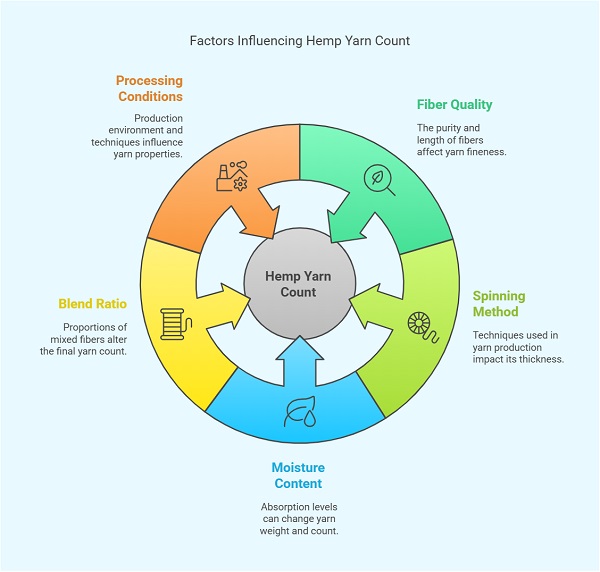Hemp Count Calculator
© Yarn Count Ltd. All rights reserved.
Disclaimer: All tools in the Yarn Count have been reviewed by the relevant spinning industry experts.
The Formula for Hemp Count
Hemp Count=Length (m) ÷ Weight (g)
Where:
- Hemp Count = The fineness or thickness of the hemp yarn.
- Length (m) = The total length of the hemp yarn in meters.
- Weight (g) = The total weight of the hemp yarn in grams.
Table of Contents
What Is Hemp Count?
Hemp count refers to the numerical value representing the fineness or thickness of hemp yarn. It is a key factor in textile production, affecting fabric texture, strength, and weight. Manufacturers and textile engineers use the count to ensure consistency in fabric production.

Hemp yarn count is measured in different systems, including:
- Ne (English Cotton Count): Number of 840-yard hanks per pound.
- Nm (Metric Count): Number of 1,000-meter lengths per kilogram.
- Tex: Weight in grams per 1,000 meters of yarn.
- Denier: Weight in grams per 9,000 meters of yarn.
Each system helps determine the yarn's suitability for weaving or knitting applications.
How to Calculate Hemp Count
Hemp count is calculated based on the yarn's weight and length. The formula varies depending on the system used:
1. English Cotton Count (Ne)
Ne=Length (yards) ÷ 840×Weight (lbs)
2. Metric Count (Nm)
Nm=Length (meters) ÷ Weight (kg)
3. Tex System
Tex = Weight (grams)×1000 ÷ Length (meters)
4. Denier System
Denier=Weight (grams)×9000 ÷ Length (meters)
These formulas help textile engineers determine the appropriate yarn count for different fabric applications.
Factors Affecting Hemp Yarn Count

1. Fiber Quality
Higher-quality hemp fibers result in finer yarns with a higher count. Short or coarse fibers produce thicker yarns.
2. Spinning Method
Ring-spun hemp yarns tend to be finer than open-end spun yarns. The spinning technique affects count accuracy.
3. Moisture Content
Hemp fibers absorb moisture, which can alter the weight and affect the count measurement.
4. Blend Ratio
When mixed with other fibers (e.g., cotton, linen), the final count depends on the blend percentage.
5. Processing Conditions
Factors like tension, twist per inch, and spinning speed influence the final yarn count.
Why Is Hemp Count Important?
1. Fabric Strength and Durability
A lower count (thicker yarn) results in stronger, more durable fabrics, suitable for upholstery or industrial textiles.
2. Fabric Texture
Finer yarns with a higher count produce softer, smoother fabrics used in fashion textiles.
3. Weaving and Knitting Compatibility
Manufacturers need the correct count to ensure proper weaving and knitting efficiency, preventing defects.
4. Standardization in Production
Maintaining a consistent yarn count ensures uniformity in fabric quality, essential for bulk production.
How to Use the Hemp Count Calculator
- Enter Yarn Length – Input the length in meters or yards.
- Enter Yarn Weight – Provide the weight in grams, kilograms, or pounds.
- Select Count System – Choose Ne, Nm, Tex, or Denier.
- Get Instant Results – The calculator will display the exact yarn count.
This tool simplifies count calculations, saving time and reducing errors in textile manufacturing.
Common Applications of Hemp Yarn
- Apparel – Used in eco-friendly clothing, t-shirts, and denim.
- Home Textiles – Ideal for curtains, rugs, and upholstery.
- Industrial Uses – Suitable for ropes, canvas, and composite materials.
- Blended Fabrics – Mixed with cotton, wool, or silk for varied textures.
Hemp yarn is a sustainable alternative in textiles, offering strength and breathability.
Conclusion
Accurate hemp count is essential for textile production, influencing fabric properties and performance. Using a hemp count calculator simplifies calculations, ensuring precise results for manufacturers. Whether for apparel, home textiles, or industrial applications, getting the right count ensures product quality and consistency.